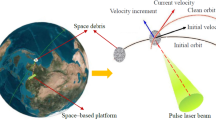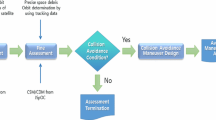Abstract
Space debris events are increasingly frequent where they are sufficiently dense that the use of low Earth orbit space has now reached the point under the effect of mutual collisions. As a mitigation method, the goal was to study the efficiency of an orbital maneuver considering the gravitational effect and ground-based laser when the space debris traveling in a heliocentric orbit in the range of 1 cm to 10 cm and altitude ranging from 100 to 1000 km makes a close approach to Earth. An analytical model was performed considering factors, such as the laser’s fluency, the debris’s inclination, and the relative movement between laser and debris. The analysis was performed through the variation of velocity and energy after a close approach considering a single pulse laser. It is important in evaluating the orbital characteristics of space debris for better reentry of Earth’s atmosphere or avoiding collisions considering the impulse magnitude performed by ground-based laser. Some results show that the laser can perform a small change in \(\Delta V\) and have maximum efficiency in energy variation of \(12 \%\) that can be accumulated and perform energy of the reentry. In that sense, this study provides the literature with a general study of this maneuver, showing its advantages over more traditional orbital maneuvers, as well as the best conditions to avoid collisions and mitigate space debris.








Similar content being viewed by others
Availability of data and materials
No data and materials associated in the manuscript.
References
J. Donald, B. Cour-Palais, Collision frequency of artificial satellites. J. Geophys. Res. 83, 2637–2646 (1978). https://doi.org/10.1029/JA083iA06p02637
D.J. Kessler, Collision probability at low altitudes resulting from elliptical orbits. Adv. Space Res. 10, 393–396 (1990). https://doi.org/10.1016/0273-1177(90)90376-B
B.S. Yu, H. Wen, D.P. Jin, Review of deployment technology for tethered satellite systems. Acta. Mech. Sin. 34, 754–768 (2018). https://doi.org/10.1007/s10409-018-0752-5
G. Feng, W. Li, H. Zhang, Removing singularity of orientation description for modeling and controlling an electrodynamic tether. J. Guid. Control. Dyn. 41, 761–766 (2018). https://doi.org/10.2514/1.G003009
G. Feng, W. Li, H. Zhang, Geomagnetic energy approach to space debris deorbiting in a low earth orbit. Int. J. Aerosp. Eng. 2019, 1–19 (2019). https://doi.org/10.1155/2019/5876861
E.J. Öpik, Collision probabilities with the planets and the distribution of interplanetary matter. Proc. R. Ir. Acad. Sect. A 54, 165–199 (1951)
D.J. Kessler, N.L. Johnson, J. Liou, M. Matney, Breckenridge: the Kessler syndrome: implications to the future space operations (2010)
F. Letizia, C. Colombo, H. Lewis, C.R. Mcinnes, et al.: Space debris cloud evolution in low earth orbit. In: 64th International Astronautical Congress (IAC), pp. 2507–2517 (2013)
F. Letizia, C. Colombo, H.G. Lewis, Small debris fragments contribution to collision probability for spacecraft in low earth orbits, in Space Safety Is No Accident. (Springer, 2015), pp.379–387
J.K. Formiga, D.P.S. Santos, F.A. Fiore, R. Moraes, A.F.B.A. Prado, Study of collision probability considering a non-uniform cloud of space debris. Comput. Appl. Math. 39, 1–15 (2020). https://doi.org/10.1007/s40314-019-0997-z
F. Prado, Powered swingby. J. Guid. Control. Dyn. 19(5), 1142–1147 (1996)
N.J. Strange, J.M. Longuski, Graphical method for gravity-assist trajectory design. J. Spacer Rockets 39, 9–16 (2002)
A.F. Helton, N.J. Strange, J.M. Longuski, Automated desing of the Europa orbiter tour. J. Spacer Rockets 39, 17–22 (2002). https://doi.org/10.2514/2.3801
D.P.S. Santos, A.F.B.A. Prado, L. Casalino, G. Colasurdo, Optimal trajectories towards near-earth-objects using solar electric propulsion (SEP) and gravity assisted maneuver. J. Aerosp. Eng. Sci 1, 51–64 (2002). https://doi.org/10.7446/jaesa.0102.06
A.F.B.A. Prado, G. Felipe, An analytical study of the powered swing-by to perform orbital maneuvers. Adv. Space Res. 40, 1769–1968 (2007). https://doi.org/10.1016/j.asr.2007.04.098
J. Formiga, A. Prado, Orbital characteristics due to the three dimensional swing-by in the Sun-Jupiter system. Int. Conf. Comput. Intell. Man Mach. Syst. Cybern. 1, 61–69 (2011)
S. Scharring, J. Kästel, G. Wagner, W. Riede, E. Klein, C. Bamann, E. Döberl, W.D. Promper, R. Weinzinger, T. Flohrer, A. Di Mira, Potential of Using Ground-based High-Power Lasers to Decelerate the Evolution of Space Debris in LEO, in Proceedings of 8th Conference on Space DEbris (Virtual), Darmstadt, Germany, 20–23 April 2021. ed. by T. Flohrer, S. Lemmens, F. Schmitz (EAS Space Debris Office, 2021), pp.1–7
J. Sinko, C. Phipps, Modeling CO2 laser ablation impulse of polymers in vapor and plasma regimes. Appl. Phys. Lett. 95, 131105 (2009). https://doi.org/10.1063/1.3234382
J. Starke, B. Bischof, al.: A potential orbital space debris removal system. In: Proceedings of NASA/DARPA Orbital Debris Conference, Chantilly VA (2009)
M. Bender, Flexible and low-cost dragon spacecraft for orbital debris removal. In: Proceedings of NASA/DARPA Orbital Debris Conference, Chantilly VA (2009)
S. Kawamoto, Y. Ohkawa, et al.: Strategies and technologies for cost effective removal of large sized objects. In: Proceedings of NASA/DARPA Orbital Debris Conference, Chantilly VA (2009)
C.R.E.A. Phipps, Removing orbital debris with lasers. Recent Pat. Space Technol. 49, 1283–1300 (2012). https://doi.org/10.1016/j.asr.2012.02.003
C. Phipps, A laser-optical system to re-enter or lower low earth orbit space debris. Acta Astronaut. 93, 418–429 (2014). https://doi.org/10.1016/j.actaastro.2013.07.031
J. Formiga, A. Prado, Studying sequences of resonant orbits to perform successive close approaches with the moon. J. Brazil. Soc. Mech. Sci. Eng. 37(4), 1391–1404 (2015). https://doi.org/10.1007/s40430-014-0254-8
J.K. Formiga, D.P.S. Santos, An analytical description of the three-dimensional swing-by. Comput. Appl. Math. 34, 491–506 (2015). https://doi.org/10.1007/s40314-014-0139-6
R. Broucke, The celestial mechanics of gravity assist. AIAA/AAS Astrodyn. Conf. AIAA Pap. 88–4220, 69–89 (1988). https://doi.org/10.2514/6.1988-4220
S. Soldini, C. Colombo, J. Scott, Solar radiation pressure Hamiltonian feedback control for unstable libration-point orbits. J. Guid. Control. Dyn. 4(40), 1374–1389 (2016)
C. Phipps, An alternate treatment of the vapor-plasma transition. Int. J. Aerosp. Innov. 3, 45–50 (2011). https://doi.org/10.1260/1757-2258.3.1.45
M. Schimitz, S. Fasoulas, J. Utzmann, Performance model for space-based laser debris sweepers. Acta Astronaut. 115, 376–386 (2015)
Acknowledgements
The authors wish to express their appreciation for the support provided by Grants \(2022/13228-9\), \(2023/01391-5\), \(2017/04643-4\), \(2016/15675-1\), from the São Paulo Research Foundation (FAPESP), Institute of Science and Technology-UNESP/ICT-São Paulo State University, grants \(309089/2021-2\) from Brazilian National Council for Scientific and Technological Development (CNPq), FINEP 0527/18 and the RUDN University Scientific Projects Grant System, project No \(202235-2-000\). Julian A. Avila is a Serra Hunter Fellow and a CNPq fellow.
Author information
Authors and Affiliations
Corresponding author
Rights and permissions
Springer Nature or its licensor (e.g. a society or other partner) holds exclusive rights to this article under a publishing agreement with the author(s) or other rightsholder(s); author self-archiving of the accepted manuscript version of this article is solely governed by the terms of such publishing agreement and applicable law.
About this article
Cite this article
Formiga, J.K.S., dos Santos, D.P.S., de Almeida Prado, A.F.B. et al. Ground-based laser effect on space debris maneuvering. Eur. Phys. J. Spec. Top. 232, 3059–3072 (2023). https://doi.org/10.1140/epjs/s11734-023-01023-z
Received:
Accepted:
Published:
Issue Date:
DOI: https://doi.org/10.1140/epjs/s11734-023-01023-z




